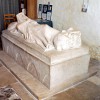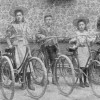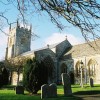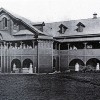In the autumn of 1862 a 21-year-old man went to the rope in Dorchester jail, a final enactment of 19th century justice for the crime of murder. The condemned man was Edwin Preedy, but perhaps it cannot be said that he was entirely in control of the depressive and violent nature that had driven him to vow he would stab a warder at the prison where he was being held for an earlier offence. For it was the fate of Preedy to suffer an unloved and cruelly deprived childhood.
Born in Leamington, Warwickshire around 1841 Edwin Alfred Preedy was the illegitimate son of a man who never knew how to bring up a child with due care and affection. His mother too, seems to have been a rather detached person who had no influence over her son. As a result of the cruelties and abuse inflicted upon him by his stepfather, seeds of anti-social rebellion and resentment were sown in Edwin’s maturing mind. Until he was eleven he attended a national school where, although he was quite clever he was also a proud, passionate and idle boy. When he was thirteen however, his mother and an aunt conspired to have the boy institutionalised in a reformatory but Edwin decamped from the school after just ten months.
There then followed a string of incarcerations for petty offences. Upon release from the last of these sentences Preedy ran away to join the Army’s 85th Regiment, even rising to the rank of corporal, but then in the company of three others deserted after stealing some clothes. When caught, Preedy was sentenced to penal servitude for three years. From his first prison he was moved, first to Millbank then to Portland. It was while serving his sentence here that Preedy, in a fit of murderous ire, vowed to a fellow inmate that he would take a knife to a warder who removed his soiled dinner plate.
So in September 1862 Preedy was transferred to Dorchester jail to await trial for murder. Personally he saw no hope of a pardon, and in his despair he frequently became violent, such that on two occasions he had to be restrained in irons respectively for 14 and 28 days.
Yet fate it seemed had not entirely given up granting Edwin Preedy an opportunity to repent and receive absolution. He told the prison chaplain that he could only foresee his “dread end.” But at this point a remarkable Anglican minister entered his life, as if sent by a redeeming angel of mercy from on high. The cleric was the then vicar of nearby Fordington, The Reverend Henry Moule BA, and his visits to the cell-bound Preedy throughout the last weeks of his life made history as perhaps the most protracted, challenging and tragic case of a priest’s attempt to save a condemned man’s soul ever recorded.
Henry Moule was a luminary among 19th century Anglicans. Early in his priestly career he boldly tackled moral laxity, ecclesiastical rectitude and the injustices of squalor and the powers that be. He was chaplain to Dorset Barracks and Vicar of Fordington and is best known for his invention of the earth-closet. But his dealings with Preedy introduced him to an altogether new dimension in human nature and pastoral experience.
Moule’s strategy was to entice Preedy into making a confession or admission of guilt, expressing remorse for what he had done. He implored the prisoner to repent of the murder and all his earlier sins. At times the vicar found the prisoner in a conciliatory and receptive mood, but at other times Moule had to endure a barrage of insolence and even physical assault. When his temper was aroused Preedy no longer wanted to be visited. One day, in Moule’s presence, he broke down: “here I am with one foot in the grave; I cannot break down this temper” he sobbed. On another occasion he alluded to other inmates in his position who said they had found peace. It is recorded that, when free in the prison yard he caught and tamed sparrows, but would then vindictively kill them.
Two weeks before his trial Preedy received a letter from his mother, in which she offered to raise money for his counsel. He told Moule he had decided to plead guilty. Surprisingly, at his trial his mother and aunt appeared as witnesses for the defence, but Preedy became abusive to all except the judge, jury and Sydney Osborne. Moule however, could not induce Preedy to see his mother and aunt after being found guilty and sentenced to death; Fordington’s vicar was even warned that the prisoner was too dangerous and unpredictable to approach! It seemed at first that Moule’s consolation of religion had fallen short of extracting from his client full and lasting contrition for his wrongdoing.
Yet Edwin Purdy went to his death with the most admirable courage and calm resignation. On his last afternoon he even took communion in the presence of three or four other warders who were glad to join him. Out of gratitude he presented five men with five bibles given to him by Sydney Osborne. And then…he felt the noose and blindfold about his head, the drop beneath his feet…
What appears to be the only source for this story is Henry Moule’s own account, written some time after the prison assignment it describes and entitled Hope Against Hope. A rare copy of this book is in the County Museum collection, available for study only by special arrangement and a handling fee of £10.
Footnote added 7th Sept,2012. In the school log book for Bradford Peverell dated 27th March 1863 there is the following entry. “Some of the children went to Dorchester to see Mr Fooks and Mr Preedy hung.” Underneath that entry is a note apparently dated 28th July 1873, which reads: ” They should not have gone had I known it and been able to prevent them. H.B.W.”



